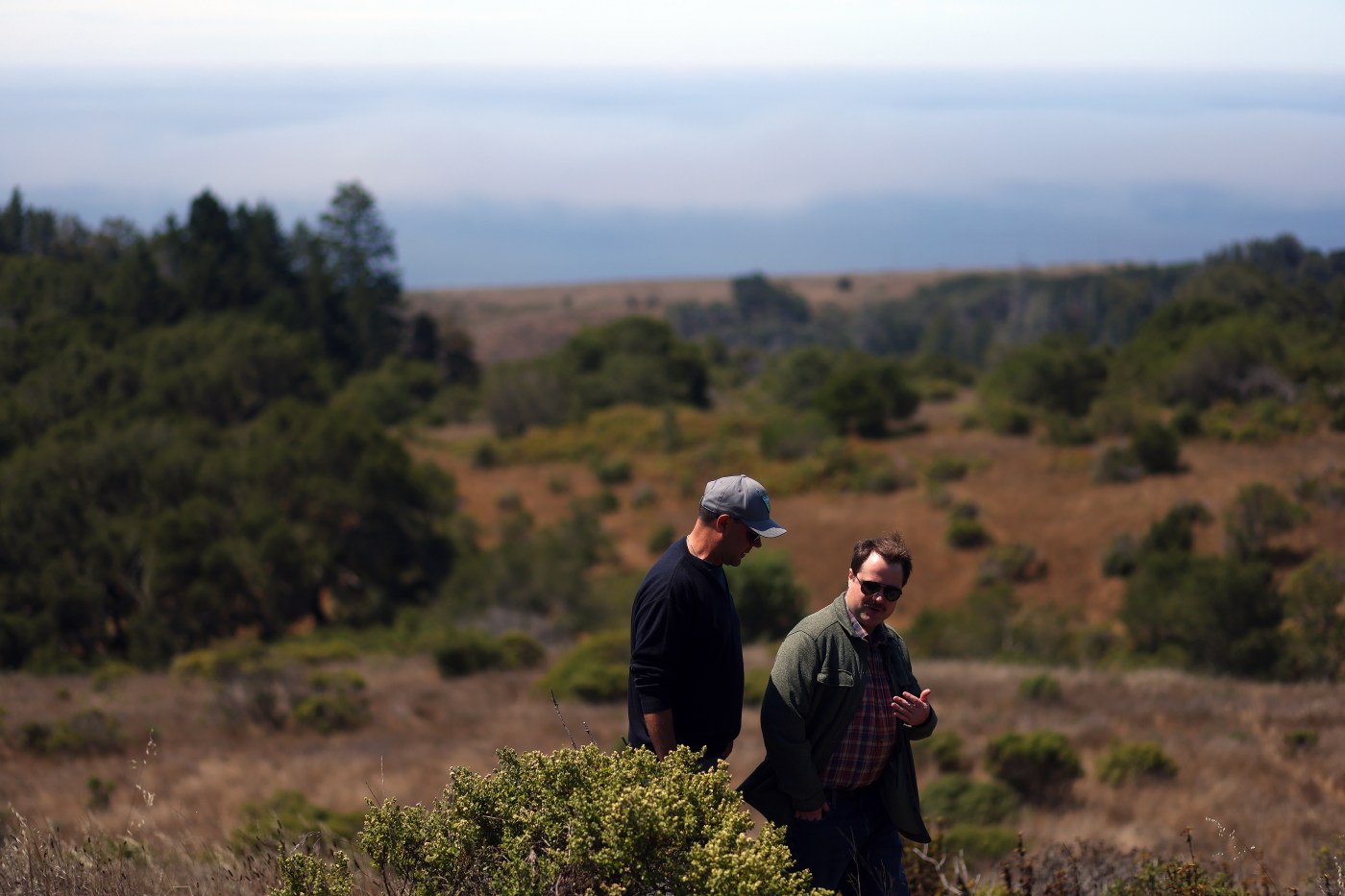
For decades, the scenic oceanfront landscape along Highway 1 north of Santa Cruz — with its coastal bluffs, rugged beaches, farm fields and redwood canyons — has been the site of big environmental battles.
PG&E planned to build a nuclear power plant there in the early 1970s. President Reagan pushed for offshore oil drilling during the 1980s. And a Nevada developer proposed a gated luxury community there in the 1990s.
But on Saturday, a new chapter begins. Coast Dairies, a breathtaking 5,843-acre property more than five times the size of San Francisco’s Golden Gate Park, will finally be open to the public.
The property, which stretches for six miles along Highway 1, was purchased by the Trust for Public Land, a San Francisco environmental group, in 1998 with $44.5 million from the David and Lucile Packard Foundation in Los Altos, the California Coastal Conservancy and other donors seeking to preserve its rural character.
In 2014, the trust donated it to the U.S. Bureau of Land Management. And in 2017, eight days before he left office, former President Barack Obama designated it as a national monument. After years of planning work and battles with community groups worried about traffic, trash, endangered species and other issues, the BLM will open a parking lot and 9 miles of trails on the property, which is officially called Cotoni-Coast Dairies, in recognition of an Ohlone tribal group who lived there centuries ago and the Swiss farmers who owned it for most of the 20th century.
Starting Saturday it will be open from dawn to dusk. Admission is free.
The parking lot, located along Cement Plant Road one mile north of the tiny town of Davenport, has 65 spaces, a restroom and picnic tables. Signs feature maps and details of the history of the area and the property’s wildlife, which includes mountain lions, steelhead trout, deer and bobcats.
The Cotoni-Coast Dairies National Monument, pictured here in 2020. (Dan Coyro; Santa Cruz Sentinel/LightHawk)
“Highway 1 is one of the most scenic roads in the world,” said Zachary Ormsby, Central Coast field manager for the BLM. “We have added 5,843 acres of outdoor recreation, wildlife protection and the opportunity to be immersed in nature. You can push your limits or you can take an easy stroll out here.”
The trails are built around three large loops. All are open to hikers and bicyclists.
“I call the loops beginning, intermediate and advanced,” Ormsby joked.
One runs three miles through coastal grasslands. The other through two miles of redwood canyons. And the third through four miles of coastal bluffs. Dogs on leashes are allowed on the first two, but not the third.
The BLM has plans for 10 more miles of trails on the southern part of the property near Panther Beach. Officials hope to open a parking lot there and the trails in 2027.
There are also plans to link the new monument’s trail system to the San Vicente Redwoods property, an 8,500-acre expanse on its northern edge that was purchased by four environmental groups in 2011, and connect it with the North Coast Rail Trail, a 7.5-mile bike and hiking trail under construction now between Wilder Ranch State Park and Davenport.
A ceremony with officials and VIPs who worked on the project for years is planned for Friday. The trails that will open to the general public Saturday were built by a non-profit group of mountain bike enthusiasts, Santa Cruz Mountains Trail Stewardship.
The group raised $2 million and provided 1,000 people who put in 10,000 hours of volunteer work after getting direction from professional trail builders, said Matt de Young, the group’s executive director.
“It was a pretty massive lift,” he said. “Really a community effort.”
De Young said it’s important for people to have access to public lands, not only for their health, but to build support for preserving more wild places.
“It’s part of the human experience to interact with nature,” he said. “A huge part of healthy communities is having access to the outdoors. It’s a community resource. Not only are we protecting this area from development but we wanted to make sure people could enjoy it and develop an appreciation and care for the natural world.”
About 400 acres of beaches were transferred to the state parks department in 2006.
The project has not been without controversy. Several groups of local residents, who were instrumental in blocking the nuclear plant, the luxury development, and other plans, opposed plans for the monument when the Sempervirens Fund, a Los Altos group that buys redwood forests for parkland, first proposed it in 2015.
“We were concerned that it would bring big crowds of people and that the federal government wouldn’t devote the resources to protecting the resources” said Dave Rubin, chairman of the Rural Bonny Doon Association, one of the groups that opposed the monument.
Rubin said his organization continues to have concerns about trash, wildfire risk and other issues. But he credited Ormsby with meeting regularly with local residents and listening to them.
“I’m looking forward to going hiking there,” he said. “I hope they have enough rangers and police to keep people from building illegal trails and fires, and I hope people take away their trash.”
Obama signed the monument after former U.S. Rep. Anna Eshoo, D-Palo Alto, flew with him on Air Force One in 2016 and urged him to sign a proclamation. Even though President Trump has pushed for more oil drilling, mining and logging on federal lands, deed restrictions that were part of the transfer to BLM prohibit them on this property.
“This has a been a long saga,” said Sara Barth, executive director of Sempervirens Fund. “It feels like a really key moment, a significant milestone, to finally open it to the public. It’s lovely. A day’s visit to this place will expose you to redwoods, and coastal marine terraces and ocean views all in one afternoon. Which is pretty spectacular.”